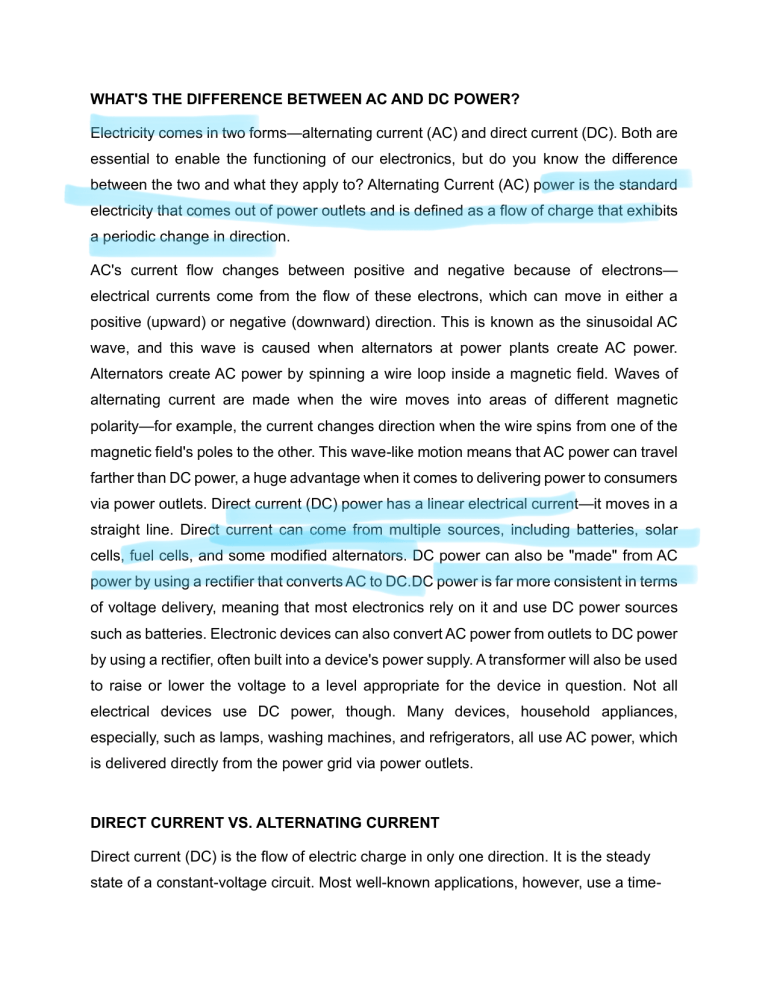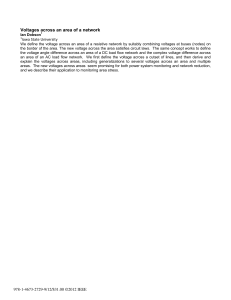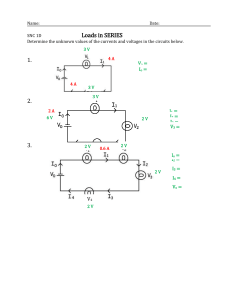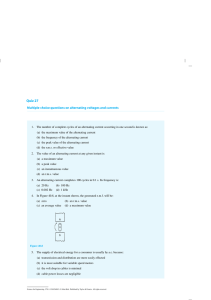
WHAT'S THE DIFFERENCE BETWEEN AC AND DC POWER? Electricity comes in two forms—alternating current (AC) and direct current (DC). Both are essential to enable the functioning of our electronics, but do you know the difference between the two and what they apply to? Alternating Current (AC) power is the standard electricity that comes out of power outlets and is defined as a flow of charge that exhibits a periodic change in direction. AC's current flow changes between positive and negative because of electrons— electrical currents come from the flow of these electrons, which can move in either a positive (upward) or negative (downward) direction. This is known as the sinusoidal AC wave, and this wave is caused when alternators at power plants create AC power. Alternators create AC power by spinning a wire loop inside a magnetic field. Waves of alternating current are made when the wire moves into areas of different magnetic polarity—for example, the current changes direction when the wire spins from one of the magnetic field's poles to the other. This wave-like motion means that AC power can travel farther than DC power, a huge advantage when it comes to delivering power to consumers via power outlets. Direct current (DC) power has a linear electrical current—it moves in a straight line. Direct current can come from multiple sources, including batteries, solar cells, fuel cells, and some modified alternators. DC power can also be "made" from AC power by using a rectifier that converts AC to DC.DC power is far more consistent in terms of voltage delivery, meaning that most electronics rely on it and use DC power sources such as batteries. Electronic devices can also convert AC power from outlets to DC power by using a rectifier, often built into a device's power supply. A transformer will also be used to raise or lower the voltage to a level appropriate for the device in question. Not all electrical devices use DC power, though. Many devices, household appliances, especially, such as lamps, washing machines, and refrigerators, all use AC power, which is delivered directly from the power grid via power outlets. DIRECT CURRENT VS. ALTERNATING CURRENT Direct current (DC) is the flow of electric charge in only one direction. It is the steady state of a constant-voltage circuit. Most well-known applications, however, use a time- varying voltage source. Alternating current (AC) is the flow of electric charge that periodically reverses direction. If the source varies periodically, particularly sinusoidally, the circuit is known as an alternating current circuit. Commercial and residential power that serves so many of our needs are some of the examples. WHY USE AC FOR POWER DISTRIBUTION? Most large power-distribution systems are AC. Moreover, the power is transmitted at much higher voltages than the 120-V AC (240 V in most parts of the world) we use in homes and on the job. Economies of scale make it cheaper to build a few very large electric power-generation plants than to build numerous small ones. This necessitates sending power long distances, and it is obviously important that energy losses in route be minimized. High voltages can be transmitted with much smaller power losses than low voltages, as we shall see. For safety reasons, the voltage at the user is reduced to familiar values. The crucial factor is that it is much easier to increase and decrease AC voltages than DC, so AC is used in most large power distribution systems. It is widely recognized that high voltages pose greater hazards than low voltages. But, in fact, some high voltages, such as those associated with common static electricity, can be harmless. So, it is not voltage alone that determines a hazard. It is not so widely recognized that AC shocks are often more harmful than similar DC shocks. Thomas Edison thought that AC shocks were more harmful and set up a DC power-distribution system in New York City in the late 1800s. There were bitter fights, between Edison and George Westinghouse and Nikola Tesla, who were advocating the use of AC in early power-distribution systems. AC has prevailed largely due to transformers and lower power losses with high-voltage transmission.





